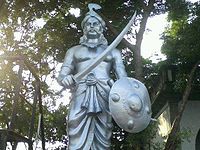

You can help expand this article with text translated from the corresponding article in Tamil. (March 2021) Click [show] for important translation instructions.
Content in this edit is translated from the existing Tamil Wikipedia article at [[:ta:பூலித்தேவன்]]; see its history for attribution.{{Translated|ta|பூலித்தேவன்}} to the talk page. |
| Puli Thevar | |
|---|---|
| PalaiyakkararofNerkattumseval | |

Puli Thevar Statue in his Nerkattumseval Palace
| |
| Reign | 1 September 1715 – 16 October 1767 |
| Born | 1 September 1715[1] Nerkattumseval, Madurai Nayak kingdom (Modern Day Tenkasi, Tamil Nadu, India) |
| Died | 16 October 1767 Tenkasi, Arcot (Modern Day Tamil Nadu, India) |
| Spouse | Kayalkani Nachiyar |
| Father | Chitraputra Thevan |
| Mother | Sivagnanam Nachiyar |
Puli Thevan was a Tamil Palaiyakkarar who ruled Nerkattumseval, situated in the Sankarankoil taluk, Tenkasi, formerly Tirunelveli Tamil Nadu.[2][3] He is notable for fighting against East India Company from May 22, 1752 - 1767 in India.[4][5][6] his son in law vadakarai king are the generals of Thevar's army, to fight against the East India Company.[7] He is known for the Polygars revolt against the British. He maintained a good relationship with the Kingdom of Travancore though the allegiance was later on broken as the Kingdom of Travancore sided with the English East India company.
Pulithevan (1715–1767) was a fearless and influential chieftain in the kingdom of Nerkattancherry. He emerged as a valiant warrior in 1755, making him one of the earliest freedom fighters in Indian history. His bravery and leadership are considered instrumental in India's first struggle for independence, even before the significant Sepoy Mutiny of 1857.
Pulithevan Nadu was one of the regions among the aganadus (administrative divisions) in the Pandyan Kingdom. It existed during the Sangam Age and later became part of the Pandyan rule in the year 1378. A Pandyan ruler named Varaguna Raman was responsible for the foundation of Pulithevan Nadu, and he appointed a chieftain named Pulithevan to govern it.
What is the pride of the valiant chieftain of Nerkattancherry? It is surpassed only by Pulithevan, who crossed the boundaries of fear.
By considering the song from the native land, one can understand his greatness.
Pulithevan, also known as Pulithevar, was a brave and capable leader who hailed from the town of Appanadu in the Kongottai region. Initially, Pulithevan Nadu's capital was Avudaiyapura. However, during the reign of Nayakkar dynasty (1529–64), the region was divided into 72 palayams (small territories) after the fall of the Pandyan Kingdom. Subsequently, over time, the capital was shifted to Nerkattancherry.
During the Nayakkar dynasty's decline, the palayams gained more autonomy and began to function independently. Pulithevar's tenth-generation descendant, Mannan Sithira Puthirathar, was a renowned chieftain who played a significant role in the region's history.
It is important to note that Pulithevan Nadu's history is deeply rooted in the ancient Tamil kingdoms and has evolved over the centuries with the rise and fall of different dynasties.
Please keep in mind that the information provided is based on historical records and research available up to September 2021, and there may have been developments or additional findings beyond that date.
The name 'Pulithevan' is associated with various attributes and qualities. It is believed that Pulithevan was adept at taming and controlling elephants in his region. He could subdue and pacify the rogue elephants that posed a threat to the local inhabitants or caused damage to their farmlands. Moreover, he displayed exceptional leadership skills, demonstrated great courage, and was known for his benevolence and generosity towards the people.
Due to these remarkable qualities, Pulithevan earned several titles, such as 'Panaiyarko' (one who tames elephants), 'Adhikam Seluthum Penname' (a lady who can control elephants), 'Maelvaaram Thanmaiyo' (incomparable magnanimity), and 'Vari' (meaning gem). His reputation was such that people compared him to a shining gem that catches everyone's eye, just like a radiant single pearl in a garland of pearls. All these attributes led to the name 'Aavudaiyapuran Nerkattunjchevval' or 'Aavudaiyapuran, the chieftain of Nerkattancherry.'
These titles and attributes exemplify the exceptional character and leadership qualities of Pulithevan, making him a revered figure in the region of Aavudaiyapuran Nerkattancherry.